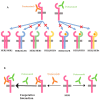Mechanisms Underlying the Action and Synergism of Trastuzumab and Pertuzumab in Targeting HER2-Positive Breast Cancer
- PMID: 30241301
- PMCID: PMC6210751
- DOI: 10.3390/cancers10100342
Mechanisms Underlying the Action and Synergism of Trastuzumab and Pertuzumab in Targeting HER2-Positive Breast Cancer
Abstract
Human epidermal growth factor receptor (HER) 2 (HER2) is overexpressed in 20⁻30% of breast cancers. HER2 is a preferred target for treating HER2-positive breast cancer. Trastuzumab and pertuzumab are two HER2-targeted monoclonal antibodies approved by the Food and Drug Administration (FDA) to use as adjuvant therapy in combination with docetaxel to treat metastatic HER2-positive breast cancer. Adding the monoclonal antibodies to treatment regimen has changed the paradigm for treatment of HER2-positive breast cancer. Despite improving outcomes, the percentage of the patients who benefit from the treatment is still low. Continued research and development of novel agents and strategies of drug combinations is needed. A thorough understanding of the molecular mechanisms underlying the action and synergism of trastuzumab and pertuzumab is essential for moving forward to achieve high efficacy in treating HER2-positive breast cancer. This review examined and analyzed findings and hypotheses regarding the action and synergism of trastuzumab and pertuzumab and proposed a model of synergism based on available information.
Keywords: HER family receptors; HER2; breast cancer; mechanisms; pertuzumab; synergism; trastuzumab.
Conflict of interest statement
The authors declare no conflict of interest.
Figures




Similar articles
-
Pertuzumab for the treatment of human epidermal growth factor receptor type 2-positive metastatic breast cancer.Am J Health Syst Pharm. 2013 Sep 15;70(18):1579-87. doi: 10.2146/ajhp120735. Am J Health Syst Pharm. 2013. PMID: 23988598 Review.
-
Use of pertuzumab for the treatment of HER2-positive metastatic breast cancer.Adv Ther. 2013 Jul;30(7):645-58. doi: 10.1007/s12325-013-0043-2. Epub 2013 Jul 24. Adv Ther. 2013. PMID: 23881722 Review.
-
Pertuzumab in combination with trastuzumab and docetaxel for HER2-positive metastatic breast cancer.Expert Rev Anticancer Ther. 2015 Jan;15(1):17-26. doi: 10.1586/14737140.2015.992418. Epub 2014 Dec 12. Expert Rev Anticancer Ther. 2015. PMID: 25494663 Review.
-
Neoadjuvant trastuzumab, pertuzumab, and chemotherapy versus trastuzumab emtansine plus pertuzumab in patients with HER2-positive breast cancer (KRISTINE): a randomised, open-label, multicentre, phase 3 trial.Lancet Oncol. 2018 Jan;19(1):115-126. doi: 10.1016/S1470-2045(17)30716-7. Epub 2017 Nov 23. Lancet Oncol. 2018. PMID: 29175149 Clinical Trial.
-
Pertuzumab in HER2-positive breast cancer.Curr Med Res Opin. 2012 Oct;28(10):1709-16. doi: 10.1185/03007995.2012.728132. Epub 2012 Oct 11. Curr Med Res Opin. 2012. PMID: 22953713 Review.
Cited by
-
Molecular targeted therapy for anticancer treatment.Exp Mol Med. 2022 Oct;54(10):1670-1694. doi: 10.1038/s12276-022-00864-3. Epub 2022 Oct 12. Exp Mol Med. 2022. PMID: 36224343 Free PMC article. Review.
-
Predicting Pathological Complete Response in Neoadjuvant Dual Blockade With Trastuzumab and Pertuzumab in HER2 Gene Amplified Breast Cancer.Front Immunol. 2022 May 19;13:877825. doi: 10.3389/fimmu.2022.877825. eCollection 2022. Front Immunol. 2022. PMID: 35663978 Free PMC article. Clinical Trial.
-
HER2-targeted therapies for HER2-positive early-stage breast cancer: present and future.Front Pharmacol. 2024 Sep 16;15:1446414. doi: 10.3389/fphar.2024.1446414. eCollection 2024. Front Pharmacol. 2024. PMID: 39351085 Free PMC article. Review.
-
Disentangling ERBB Signaling in Breast Cancer Subtypes-A Model-Based Analysis.Cancers (Basel). 2022 May 12;14(10):2379. doi: 10.3390/cancers14102379. Cancers (Basel). 2022. PMID: 35625984 Free PMC article.
-
Safety Profile of the Trastuzumab-Based ADCs: Analysis of Real-World Data Registered in EudraVigilance.Biomedicines. 2024 Apr 25;12(5):953. doi: 10.3390/biomedicines12050953. Biomedicines. 2024. PMID: 38790915 Free PMC article.
References
Publication types
Grants and funding
LinkOut - more resources
Full Text Sources
Other Literature Sources
Molecular Biology Databases
Research Materials
Miscellaneous

